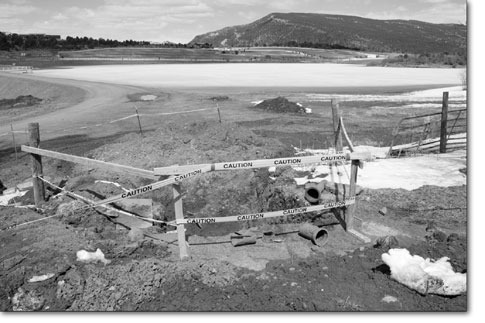| ||
| Homeland Security lands in Durango City Reservoir upgrades draw strong reactions SideStory: Something in the water: Has City Reservoir already been poisoned?
by Will Sands Homeland Security is paying a visit to Durango. In response to a recommendation from the federal government, the City of Durango has plans to secure its water supply this summer with an $80,000 fence. However, impacts to wildlife, the loss of trail access and the cost to taxpayers are much higher on some residents’ list of concerns than threats from terrorists. City Reservoir is a body of water that sits northeast of the Skyridge and Hillcrest neighborhoods, high above downtown Durango. The man-made lake is fed by the Florida and Animas rivers and contains the drinking water that is treated and then flows from Durango taps. The city owns 61 acres of property surrounding the reservoir, and based on a strong recommendation from the Department of Homeland Security, plans to surround the entire 61 acres with a 6-foot tall fence. The $80,000 price-tag for the security measure would be picked up by local taxpayers. The primary goal is to keep people from poisoning the local supply of drinking water. “The project is related to Homeland Security issues,” explained Gregg Boysen, City of Durango engineer. “The City is looking to secure the property to the best of its ability, and the fence is the first step. The City is also looking at installing an alarm system that would indicate any intruders passing through the fence.” The fence also will go beyond keeping terrorism at bay. Trespassing has long been a problem at City Reservoir, and the fence would discourage unauthorized “recreation.” “There has been a concern about the safety of public water supplies from a homeland security perspective,” said Public Works Director Jack Rogers. “But we also have a lot of people who trespass on city property and use City Reservoir for recreation of one kind or another.” The 61 acres surrounding the reservoir also drain into the body of water, according to Rogers and Boysen. By fencing off the large area, there is hope that contamination can be reduced in the drinking water. “The 61 acres were assembled to protect our watershed,” Boysen said. “One of the reasons we want it fenced is to protect residents’ drinking water.” However, numerous residents are not buying the Homeland Security or cleanliness arguments. Instead, they are pointing to several impacts that will result from the fence. A leading concern is that the fence will not be wildlife friendly. The Colorado Division of Wildlife recommends 8-foot tall fences constructed with thick mesh. A 6-foot fence has been suggested for City Reservoir. “Foxes, coyotes, skunks and other animals use that reservoir as a water source and they would be completely blocked,” argued Durango resident Sandra Butler. “Deer getting caught up in the 6-foot fence would be the biggest problem. Having dead animals in the city watershed isn’t exactly a good thing either.” Dave Wegner, of the Friends of the Animas River, commented that City Reservoir is the only real water source for animals living on College Mesa or in the vicinity of Horse Gulch. “By fencing, we’re going to cut off access to a lot of critters that depend on City Reservoir as a water source,” he said. “The City has said they’ll just have to go elsewhere. The problem is we don’t have a lot of other options for the wildlife up there.” Boysen countered that the city has examined a variety of fencing options. A 6-foot fence is more cost effective and will blend with the adjoining neighborhood, he added. “We looked at installing the DOW standard deer fence,” Boysen said. “But we thought it would be way too obtrusive for the neighborhood. We thought if we could make the fence as residentially friendly as possible, it would be more palatable for the neighbors.” In addition to cutting off a wildlife corridor, the new fence will also cut off a human transportation corridor. Crossing the city’s 61 acres and eight adjoining private parcels is a long-popular hiking trail. The fence will eliminate public access to the trail. In a letter to the city engineer, neighborhood resident Ward Olson wrote, “Upon walking the area this morning, I was dismayed to discover that your proposed boundary fence would close access to a trail that I have been utilizing for over 10 years that borders the reservoir on the eastern side, adjoining Skyridge Development. Over the years, I have observed hundreds of people utilizing this trail.” Olson then went on to add, “ … it is highly contradictory that on one hand, the City of Durango seems to promote open space, hiking trails, connector trails, bike paths, wildlife areas, etc. but on this instance takes the position that these considerations are trumped by ‘Homeland Security Objectives.’” Boysen responded that the city is currently working to find an alternate trail. “I’ve promised the neighbors that we will look at alternate routes for the trail,” Boysen said. “We don’t have an answer to that yet, but we’re getting to it.” Wildlife and trail access aside, Wegner, Olson and Butler have all questioned whether an $80,000 fence to satisfy Homeland Security concerns is a legitimate use of tax dollars. “I think it’s a big waste of money,” Butler said in closing. “It seems like a knee-jerk reaction that’s extremely expensive. Not that I’m actually worried about terrorists targeting Durango, but there’s got to be better ways to address this.” •
|
In this week's issue...
- May 15, 2025
- End of the trail
Despite tariff pause, Colorado bike company can’t hang on through supply chain chaos
- May 8, 2025
- Shared pain
Dismal trend highlights need to cut usage in Upper Basin, too
- April 24, 2025
- A tale of two bills
Nuclear gets all the hype, but optimizing infrastructure will have bigger impact


